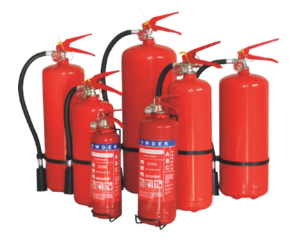Inlet Thread: G1/2-14
Outlet Thread: M12X1.25
Gauge Connection Thread: G1/8x28
Dip Tube Thread: G1/4x19
Content
Deformation/corrosion: The bottle is obviously dented, swollen, deformed, or has large-scale peeling or powder/air leakage due to rust or chemical corrosion.
Cracks/breakage: Visible cracks in the bottle, nozzle, pressure gauge, or other parts, or the spray hose is aging and cracking, or the connection is loose.
The fire extinguisher's safety pin (bolt) and seal must be intact. If the pin is missing, broken, or the seal is damaged (opened privately by non-professionals), it may cause internal pressure leakage or agent deterioration.
The pressure gauge is the core basis for judging whether the fire extinguisher is effective. The status is distinguished by color identification (the color may vary from manufacturer to manufacturer, please refer to the dial description):
Green area: Normal pressure, can be used normally.
Red area (pointer points to "RECHARGE" or "underpressure"): Insufficient pressure, cannot guarantee effective spraying, and needs to be refilled immediately. Yellow area (some fire extinguishers have it, pointing to "OVERCHARGE" or "overpressure"): The pressure is too high, and there may be a risk of explosion of the bottle due to high temperature or overfilling. It is strictly prohibited to use it.

Two deadlines need to be paid attention to:
Scrap age (overall replacement): According to the type of fire extinguisher, the national mandatory scrap age is:
Water-based fire extinguishers: 6 years
Dry powder, clean gas fire extinguishers: 10 years
Carbon dioxide fire extinguishers: 12 years
Repair and refilling period (regular inspection and replacement): Even if the scrap age has not been reached, it must be refilled/repaired according to the prescribed period (for example, dry powder fire extinguishers are usually inspected every 2 years and must be refilled by a professional organization when they expire).
Dry powder fire extinguisher: If you hear a clear "agglomeration sound" when shaking the bottle, or the agent is "sprayed out in blocks" instead of uniform powder when spraying, it means that the dry powder has become damp and agglomerated and cannot effectively extinguish the fire.
Water-based fire extinguisher: If the agent is turbid, stratified, has sediment, or the nozzle is blocked and cannot be sprayed, it is a sign of failure. Carbon dioxide fire extinguisher: The weight becomes significantly lighter (CO₂ leakage), or there is no gas or weak gas when spraying.
When manually operated, the pressure handle cannot be pressed down, no agent is sprayed out of the nozzle, or the spray distance is significantly shortened (for example, the normal range is more than 3 meters, but it is only about 1 meter after failure).
High temperature/low temperature: Long-term storage in direct sunlight, near a heat source (such as next to a kitchen stove) or in an environment below -10℃ will cause the agent to deteriorate and the pressure to be abnormal (CO₂ fire extinguishers are prone to pressure drop at low temperatures).
Humid/corrosive environment: Humid places such as basements and bathrooms can easily cause the bottle to rust and the agent to get damp (especially dry powder fire extinguishers).
Collision or vibration: Severe collision during transportation or storage may cause internal components to loosen, the pressure gauge to be damaged, or the seal to fail.
Appearance: The bottle is free of deformation and rust, the nozzle and hose are intact, and the latch and seal are intact.
Pressure: The pressure gauge pointer is in the green zone (some fire extinguishers do not have the yellow zone; the red "underpressure" and green "normal" indicators are used as the standard).
Date: The "Manufacture Date" and "Next Service Date" on the bottle label are not past the expiration date (e.g., if manufactured in 2020, a dry powder fire extinguisher requires service and inspection in even-numbered years such as 2022 or 2024).
Important Notice: Immediately discontinue use: If any of the above failure indicators (such as abnormal pressure, expiration date, bottle damage, or clumping of the agent) are observed, discontinue use immediately and contact a qualified fire equipment company for repair, refilling, or disposal.
Regular Inspection Responsibility: Businesses and households should conduct a monthly visual inspection of their fire extinguishers and have them fully inspected by a professional at least once a year to ensure they are readily available for use at critical moments.